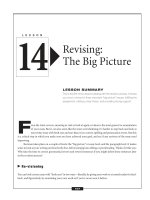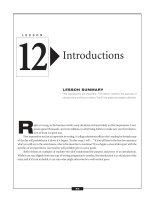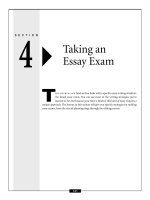How to Write an Essay
Bạn đang xem bản rút gọn của tài liệu. Xem và tải ngay bản đầy đủ của tài liệu tại đây (64.56 KB, 3 trang )
How to Write an Essay !!!
How to Write an Essay
An essay is a short piece of writing that generally shows the author's view on a particular
subject. There are many different kinds of essays, including narrative, descriptive, and
persuative. The following steps, however, can be used to write any kind of essay.
Establish your topic
Organize your ideas
Write a first draft
Revise the first draft
Proofread the final draft
Establish Your Topic
Your teacher may assign you a topic or ask you to choose from among a few topics. The
assignment may contain certain key words that will suggest the content and structure of
your essay. For example, you may be asked to
Analyze
Argue
Compare and contrast
Describe
Discuss
Summarize
If you do not understand what you are being asked to do, check with your teacher.
You may be asked to find a topic on your own. Most people find this difficult. Give
yourself plenty of time to think about what you'd like to do. Trying to answer questions you
have about a particular subject may lead you to a good paper idea.
What subject(s) are you interested in?
What interests you most about a particular subject?
Is there anything you wonder about or are puzzled about with regard to that subject?
Be sure your topic is narrow enough so that you can write about it in detail in the number
of pages that you are allowed. For example, say you are asked to write a 1-page essay
about someone in your family. Since you only have a limited number of pages, you may
want to focus on one particular characteristic of that person, or one particular incident from
that person's life, rather than trying to write about that person's entire life. Having a narrow
focus will help you write a more interesting paper.
Too general: My sister.
Revised: My sister is my best friend.
Similarly, you may be asked to write a 5-page paper about volcanoes. Again, since you
only have a limited number of pages, you may choose to focus on one particular volcano or
one particular eruption, rather than trying to talk about volcanoes in general.
Too general: Volcanoes of the world.
Revised: The eruption of Mt. Pinatubo in June 1991.
One method for narrowing down your topic is called brainstorming. Brainstorming is a
useful way to let ideas you didn't know you had come to the surface.
Sit down with a pencil and paper, or at your computer, and write whatever comes into your
head about your topic, no matter how confused or disorganized.
Keep writing for a short but specific amount of time, say 3–5 minutes. Don't stop to change
what you've written or to correct spelling or grammar errors.
After a few minutes, read through what you have written. You will probably throw out
most of it, but some of what you've written may give you an idea you can develop.
Do some more brainstorming and see what else you can come up with.
Organize Your Ideas
Develop an outline to organize your ideas. An outline shows your main ideas and the order
in which you are going to write about them. Click here to see some sample outlines.
Write down all the main ideas.
List the subordinate ideas below the main ideas.
Avoid any repetition of ideas.
Write a First Draft
Every essay or paper is made up of three parts:
Introduction
Body
Conclusion
The introduction is the first paragraph of the paper. It often begins with a general statement
about the topic and ends with a more specific statement of the main idea of your paper. The
purpose of the introduction is to
let the reader know what the topic is
inform the reader about your point of view
arouse the reader's curiosity so that he or she will want to read about your topic
The body of the paper follows the introduction. It consists of a number of paragraphs in
which you develop your ideas in detail.
Limit each paragraph to one main idea. (Don't try to talk about more than one idea per
paragraph.)
Prove your points continually by using specific examples and quotations.
Use transition words to ensure a smooth flow of ideas from paragraph to paragraph.
The conclusion is the last paragraph of the paper. Its purpose is to
summarize your main points, leaving out specific examples
restate the main idea of the paper
Revise the First Draft
Try to set aside your draft for a day or two before revising. This makes it easier to view
your work objectively and see any gaps or problems.
Revising involves rethinking your ideas, refining your arguments, reorganizing paragraphs,
and rewording sentences. You may need to develop your ideas in more detail, give more
evidence to support your claims, or delete material that is unnecessary. For more advice on
revising and a sample revision.
Read your paper out loud. This sometimes makes it easier to identify writing that is
awkward or unclear.
Have somebody else read the paper and tell you if there's anything that's unclear or
confusing.
Proofread the Final Draft
Look for careless errors such as misspelled words and incorrect punctuation and
capitalization.
Errors are harder to spot on a computer screen than on paper. If you type your paper on a
computer, print out a copy to proofread. Remember, spell checkers and grammar checkers
don't always catch errors, so it is best not to rely on them too much.
Good luck!!









